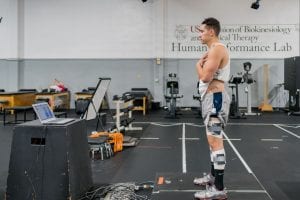
 It is possible that individuals adopt compensatory strategies early after surgery or injury that continue into late rehabilitation. Weight-bearing is encouraged soon after surgery to promote graft healing however; the ability to restore typical loading patterns during early rehabilitation is challenged by the presence of postoperative pain, quadriceps strength deficits and decreased range of motion. Our work suggests that during early rehabilitation, individuals following ACLr can meet the demands of loading when given appropriate feedback regarding performance, but do not naturally adopt symmetrical loading patterns. This is observed during biomechanical assessments of bilateral squatting tasks and gait at times during which the demands of these tasks are considered submaximal. Moreover, we have quantified unloading of the surgical limb throughout the day suggesting that these strategies carry over into daily loading behaviors. This is concerning as the loading practice afforded in daily activities, by virtue of its volume, can serve as a powerful mechanism for the development and maintenance of mal-adaptive underloading strategies
It is possible that individuals adopt compensatory strategies early after surgery or injury that continue into late rehabilitation. Weight-bearing is encouraged soon after surgery to promote graft healing however; the ability to restore typical loading patterns during early rehabilitation is challenged by the presence of postoperative pain, quadriceps strength deficits and decreased range of motion. Our work suggests that during early rehabilitation, individuals following ACLr can meet the demands of loading when given appropriate feedback regarding performance, but do not naturally adopt symmetrical loading patterns. This is observed during biomechanical assessments of bilateral squatting tasks and gait at times during which the demands of these tasks are considered submaximal. Moreover, we have quantified unloading of the surgical limb throughout the day suggesting that these strategies carry over into daily loading behaviors. This is concerning as the loading practice afforded in daily activities, by virtue of its volume, can serve as a powerful mechanism for the development and maintenance of mal-adaptive underloading strategies
Related Publications:
Lin PE, Sigward SM. Influence of hamstrings on knee moments during loading response of gait in individuals following ACL reconstruction. Journal of Orthopaedic Research, https://doi.org/10.1002/jor.24465-Ahead of Print, 10/2019
Chan M-S, Sigward SM. Loading Behaviors Do Not Match Abilities Post Anterior Cruciate Ligament Reconstruction. Medicine & Science in Sports & Exercise, 51(8)1626-1634, 2019
Lin PE, Sigward SM. Subtle Alterations in Whole Body Mechanics During Gait Following Anterior Cruciate Ligament Reconstruction. Gait & Posture, 68:494-499, 2019
Lin PE, Sigward SM. Contributors to Knee Loading Deficits During Gait in Individuals Following Anterior Cruciate Ligament Reconstruction. Gait & Posture, 66:83-87, 2018
Sigward SM, Chan MS, Lin P, Almonsouri SY, Pratt KA. Compensatory Strategies that Reduce Knee Extensor Demands During a Bilateral Squat Change from 3 to 5 Months Following Anterior Cruciate Ligament Reconstruction. Journal of Orthopedic and Sports Physical Therapy, 48(9): 713-718, 2018
Pratt KA and Sigward SM. Knee Loading Deficits during Dynamic Tasks in Individuals following ACL Surgery. Journal of Orthopedic and Sports Physical Therapy. 47(6): 411-419, 2017
Sigward SM, Chan M-S and Lin PE. Characterizing Knee Loading Asymmetry in Individuals Following Anterior Cruciate Ligament Reconstruction Using Inertial Sensors. Gait & Posture, 49: 114-119, 2016
Sigward SM, Lin PE, Pratt KA. Knee loading asymmetries during gait in early recovery are related to asymmetries in late recovery and during running following ACL reconstruction. Clinical Biomechanics, 32: 249-54, 2016.
Funding: California Physical Therapy Fund, 1/2014-12/2014 ($9,095)